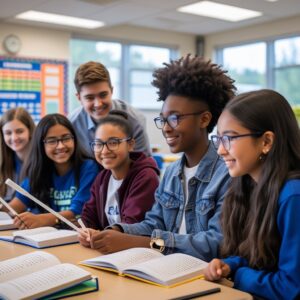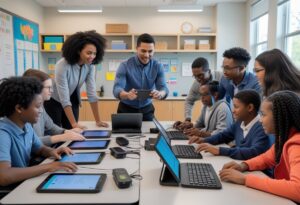Adapting the Classroom for Children with Low Vision: Practical Strategies for Inclusive Learning

Why Adapting the Classroom for Children with Low Vision Matters
Every child deserves a supportive learning environment, and this is especially important for students with low vision or visual impairment. By making thoughtful classroom adaptations, we can promote independence, improve access to materials, and create a space where all students can thrive.
We understand that educators play a crucial role in inclusive education. From improving contrast and lighting to reducing visual clutter and glare, practical changes can make classrooms safer and more accessible to students who are visually impaired. For more ideas, see paths to helpful classroom design tips.
At New England Low Vision and Blindness, our mission is to bring hope by offering leading-edge assistive technology and life-changing resources. Together, we can help students with low vision actively participate and reach their potential in the classroom.
Understanding Low Vision in the Classroom
Low vision and other forms of visual impairment affect every aspect of a student’s classroom experience. By understanding the types of impairment, how to identify them, and the importance of tailored assessment, we can help visually impaired students access opportunities, learning, and independence.
Identifying Visual Impairment
Visual impairment in children may not always be immediately obvious. Some signs include trouble recognizing faces, holding books very close to their eyes, frequent squinting, or sensitivity to light.
Teachers and staff should pay attention to behavioral cues such as a child having difficulty locating objects, bumping into furniture, or needing extra time to visually process classroom information. Sudden changes in a student’s academic performance can also be a signal.
Routine vision screenings can be helpful, but some low vision conditions, like cataracts or reduced visual acuity might not be found through standard testing alone. Early identification allows us to intervene quickly and begin adapting the learning environment for better accessibility. We encourage educators to collaborate closely with families, School Nurses, and low vision professionals.
Common Types of Visual Impairment
Visual impairments can include a range of conditions, from mild vision loss to complete blindness. Common types are:
- Low Vision: Reduced vision that cannot be corrected fully with glasses.
- Blindness: Very limited or no light perception.
- Cataracts: Clouding of the lens, causing blurry or hazy vision.
- Macular Degeneration and Retinitis Pigmentosa: Progressive loss of central or peripheral vision.
The functional impact depends on the type and severity of impairment. Students with similar clinical diagnoses may have very different experiences and needs in the classroom. Understanding these distinctions helps us select the most effective support strategies and leading-edge assistive technology.
Individual Needs and Assessment
Each visually impaired child is unique, with individual needs shaped by the degree of vision loss, co-existing sensory impairments, and their learning environment. No single solution works for all, so individualized assessment is essential.
Effective assessments consider visual acuity, field of vision, light sensitivity, and the student’s usual classroom activities. We also review technology use, mobility challenges, and communication needs as part of our process. Collaboration with Teachers of the Visually Impaired (TVIs), families, and specialists ensures a well-rounded understanding of student abilities and required accommodations.
Personalized educational plans allow us to address both strengths and challenges, supporting visually impaired students in all aspects of classroom life. Adaptive strategies and environmental modifications become the foundation for effective learning.
Environmental Modifications for Accessibility
Creating a supportive classroom environment for children with low vision requires careful adjustments to layout, lighting, and the use of color and contrast. Each element can significantly influence how effectively students access materials and navigate the space.
Classroom Layout and Seating Arrangements
Arranging the classroom for maximum accessibility starts with considering the placement of desks, tables, and frequently used materials. We recommend positioning students with low vision near instructional areas such as whiteboards or smartboards, ensuring their line of sight is unobstructed by furniture or classmates. Flexible seating options allow for adjustments as needed, especially if visual acuity varies during the day.
It is important to minimize visual clutter on and around work surfaces. Shelving, supplies, and decorations should be organized and kept to a minimum to avoid distractions and confusion. Clear pathways between areas prevent accidents and aid orientation. Labeling doors, storage units, and equipment with large print or tactile symbols makes items easier to find.
Lighting and Illumination
Consistent, even lighting can make a dramatic difference in visual accessibility. We advise maximizing natural light where possible by placing desks near windows and using blinds to control glare. For artificial lighting, select adjustable lamps or overhead lights that reduce shadows and provide uniform illumination throughout the room.
Glare is a common concern for low vision students. Matte finishes on tables, desks, and boards help reduce reflections. Task lighting, such as adjustable desk lamps or under-cabinet lights, may be necessary for specific activities like reading or writing. Flickering fluorescent bulbs should be replaced promptly, as they can cause strain and discomfort.
Use of Contrast and Color
Contrast is essential for helping students distinguish objects, read materials, and move safely. High-contrast color combinations—such as black on white, or yellow on blue—are best for printed materials, classroom signs, and labels. Chalkboards and whiteboards should have clear, bold markings that stand out from the background.
Use color strategically to differentiate between surfaces, tools, or boundaries. For example, use bright tape or contrasting paint on the edges of steps, door frames, and classroom equipment. Avoid busy patterns on floors or walls, which can be visually confusing. Consider providing students with assistive materials like bold-lined paper and high-contrast keyboards.
Teaching Strategies and Instructional Adaptations
Our experience as leading assistive technology providers has shown us that students with low vision benefit most when both materials and teaching approaches are customized, and when the classroom integrates advanced tools designed for accessibility. These adaptations help remove barriers, support independence, and drive academic success.
Adapting Learning Materials
Making curriculum materials accessible is essential for students with low vision. Printed resources should use large, clear fonts and strong contrasting colors to maximize readability. Key documents, worksheets, and classroom visuals can be adapted by enlarging print, offering digital copies, or providing tactile alternatives like raised line drawings.
Braille textbooks and tactile graphics are vital for students who are proficient in braille, offering equal access to literacy and core subjects. Color-coding and high-contrast labeling on classroom supplies can increase independent participation in daily activities. Here’s a simple table outlining effective material adaptations:
| Adjustment Type | Example |
| Font size | Large print books, handouts in 18pt+ font |
| Contrast enhancement | Black text on yellow or white backgrounds |
| Alternative formats | Braille, audio recordings, tactile graphics |
| Organization aids | Bold labels, color tabs, textured markers |
We find that offering printed and digital formats supports different preferences and learning styles (learn more about classroom adaptations at Paths to Literacy.
Differentiating Teaching Strategies
Successful instruction for visually impaired learners depends on flexibility and proactive planning. Breaking lessons into smaller chunks, providing oral descriptions of visual content, and allowing extra time for assignments are accommodations that can make a difference. We encourage the use of verbal explanations and hands-on activities that don’t rely solely on visual cues.
Visual impairment often requires modifications in assessments. Alternatives like oral exams, project-based assignments, or using tactile materials allow students to demonstrate understanding in a format that works for them. It’s helpful to offer visual, auditory, and tactile experiences to reinforce learning and encourage engagement. Additional tips and practical strategies for adapting lessons can be found at Brookes Publishing.
Incorporating Assistive Technology
Integrating leading-edge assistive technologies is central to creating an inclusive environment. Tools such as magnifiers, screen readers, text-to-speech software, and electronic magnification devices empower students to access printed and digital information independently. Many students also benefit from refreshable braille displays and accessible tablets or computers with built-in visual accessibility features.
We often recommend magnification software for computers, apps that convert text to speech, or portable video magnifiers for on-the-go reading. These technologies not only break down access barriers but also foster independence and academic confidence in low vision learners. For further information on choosing and using assistive technology, explore our resources on implementing adaptive teaching.
Essential Assistive Technologies for Low Vision
Supporting Student Independence and Confidence
Children with low vision thrive when we empower them to become autonomous in their learning environments and daily lives. Encouraging both practical skill development and emotional resilience ensures blind students and those with low vision can fully participate in inclusive education settings.
Fostering Independence in the Classroom
We help foster independence by giving students regular opportunities to use assistive technology, magnifiers, and devices tailored to their needs. Providing clear, organized spaces with high-contrast labels and tactile markers supports orientation and mobility. Teachers and staff can collaborate to make classroom resources accessible, for example, using large print, audio formats, or tactile maps.
Opportunities to practice mobility with tools such as a white cane should be encouraged and supported in daily classroom routines. With guidance, students can learn to independently locate materials, navigate the room, and participate in group tasks. Peer support systems also play a critical role in promoting autonomy without fostering dependency.
Key Tools for Classroom Independence
| Tool | Purpose |
| White cane | Mobility and navigation |
| Tactile maps | Spatial orientation |
| Magnification | Access to print materials |
| Audio technology | Alternative text access |
Developing Self-Confidence
Building self-confidence in visually impaired students goes beyond academic success—we must reinforce positive self-image and advocacy. We actively reinforce skills that encourage self-advocacy, such as asking for accommodations and sharing needs with others. Recognition of achievements, no matter how small, creates a culture of encouragement and belonging.
Allowing safe risk-taking, such as leading a classroom activity or presenting work, helps students see themselves as capable learners. Regular feedback that is specific and constructive leads to growth and assurance in their abilities.
Steps for Building Student Confidence
- Set realistic goals together.
- Celebrate progress.
- Teach self-advocacy.
- Foster participation in discussions.
Extracurricular and Social Activities
Participation in extracurricular and social activities is vital for the wellbeing and development of blind students. We ensure access by providing materials in accessible formats and by working closely with coaches, club leaders, and peers to implement necessary adaptations.
Inclusive after-school clubs, music programs, and sports can be adapted with tactile markings, verbal instructions, and paired participation. These experiences help students broaden their interests, develop friendships, and practice social skills gained in the classroom.
Being active outside academics enhances confidence and independence, providing a balanced school life. For more insight on supporting students during activities beyond the classroom, refer to these effective strategies for inclusive involvement.
Making Extracurriculars Accessible
- Adapted materials
- Peer partnerships
- Skill-building workshops
- Participation in planning activities
Professional Development for Educators: Adapting the Classroom for Children with Low Vision
Supporting visually impaired students demands specific professional development for educators. We find that ongoing training and collaboration are essential to meeting individual needs and delivering inclusive education.
Training in Visual Impairment Strategies
Educators need access to specialized training that covers essential topics such as adapted instructional methods, leading-edge assistive technology, and environmental modifications. Our training programs equip teachers with interventions tailored to students with low vision, ensuring they can utilize tactile resources, high-contrast materials, and accessible digital content.
Key training components often include:
- Identifying student strengths and needs
- Selecting appropriate magnification and reading aids
- Integrating screen readers and voice output devices
- Designing curriculum modifications
Regular professional development sessions allow us to remain current on best practices in supporting students with visual impairments. This not only improves teaching outcomes, but also helps cultivate an inclusive education environment that builds student confidence and independence. For more information about high-quality professional practice, Teaching Students with Visual Impairments outlines standards crucial to our field.
| Training Focus | Purpose | Example |
| Tactile Resources | Enhance sensory learning | Braille, tactile diagrams |
| Tech Integration | Improve digital accessibility | Screen readers, magnifiers |
| Curriculum Design | Personalize learning experiences | Large print, modified worksheets |
Collaboration With Specialists
Collaboration with Teachers of the Visually Impaired, orientation and mobility specialists, and assistive technology trainers is vital. Through regular communication and team meetings, we share insights, set goals, and refine interventions for each learner.
Working closely with these experts helps us address unique learning challenges and monitor each student’s progress. We also use joint planning sessions to review classroom modifications, test new devices, and discuss strategies for skill development.
Shared expertise strengthens the inclusive education process, ensuring every child’s needs are understood and met. Access to resources and collaborative networks, such as those highlighted in differentiating instruction for students who are blind and with low vision, keeps our understanding sharp and our interventions effective.
Roles in Collaborative Teams
| Role | Contribution |
| TVI | Customized instructional strategies |
| O&M Specialist | Safe, confident navigation |
| Tech Trainer | Device training and technical support |
Frequently Asked Questions
Supporting children with low vision in educational settings involves specific teaching approaches, physical adaptations, and effective use of assistive technology. Educators play a key role in helping students overcome challenges by providing tailored accommodations and structured educational plans.
What are effective strategies for teaching students with visual impairments in inclusive classrooms?
We recommend using multi-sensory instruction and verbal descriptive teaching methods. Giving clear verbal directions, providing tactile materials, and utilizing hands-on activities can enhance understanding and engagement.
Group collaboration and peer support foster social inclusion and help build confidence among visually impaired students. Consistent routines and well-organized materials help students anticipate tasks and feel secure.
How should a classroom be physically adapted to support the needs of children with low vision?
Classrooms should be arranged to minimize obstacles and maintain clear, wide pathways. We suggest using contrasting colors and adequate lighting to highlight critical features such as doorways, whiteboards, and desk edges.
Labels with large, clear fonts and tactile markers on essential items make navigation and identification easier. Flexible seating arrangements allow students to sit closer to instructional displays when necessary.
What specific accommodations can be made to assist visually impaired students during lessons?
Accommodations like providing materials in large print, audio formats, and digital text can make content accessible. Allowing extra time for assignments and tests is crucial for success.
Offering preferential seating ensures learners have a clear line of sight to teachers and smart boards. Teachers can present worksheets on non-glossy paper to reduce glare and use high-contrast ink.
- Large print worksheets
- High-contrast classroom signage
- Audio-recorded reading assignments
Which assistive technologies are beneficial for learners with visual impairments in a classroom setting?
Accessible technology includes electronic video magnifiers, text-to-speech software, digital recorders, and screen readers. Digital tablets with magnification features also offer students independence.
We help educators select and train on leading-edge classroom tools that meet individual student needs, ensuring students’ access to essential resources for reading, writing, and research.
What are the common challenges faced by visually impaired students in the classroom?
Low vision students may struggle with reading standard print, navigating busy or cluttered spaces, and participating in visually dependent activities. Social isolation can also occur when students feel different from their peers.
Teachers can address these barriers by fostering an inclusive atmosphere and adapting classroom resources to each student’s needs. Consistent communication with families, specialists, and the student is key.
How can educators develop a 504 Plan to support the educational needs of visually impaired students?
A 504 Plan outlines specific accommodations, services, and instructional strategies for students with low vision. Collaboration with vision specialists, parents, and the student helps create actionable goals.
Accommodations may include accessible instructional materials, assistive technology, and environmental modifications. Regular reviews ensure the plan remains effective as the student’s needs evolve.
👉Download this content as a PDF
https://nelowvision.com/wp-content/uploads/2025/07/Adapting-the-Classroom-for-Children-with-Low-Vision_-Practical-Strategies-for-Inclusive-Learning.pdf
Empower Your Classroom with Inclusive Strategies
Are you ready to transform your classroom for students with low vision?
Explore practical training, proven adaptations, and the latest assistive technologies to ensure every student thrives. Whether you’re an educator, school administrator, or support professional, our tailored Education & Training Services equip you with the tools and confidence to create a truly inclusive learning environment.
👉 Learn more and schedule your customized training today: nelowvision.com/training-services/education-training-services/



